Abstract
During the Late Neolithic and Bronze Age, the spread of Triticeae crops gradually transformed local millet agriculture in the Gansu–Qinghai region. However, few studies focused on the distribution characteristics and geographical factors influencing Triticeae agriculture. Here, geographical data from 65 sites with barley (Hordeum vulgare) and wheat (Triticum aestivum) remains in Gansu–Qinghai region were studied by spatial analysis in ArcGIS. The results showed that spatiotemporal distribution of barley and wheat exhibited three stages: firstly appeared in the central Hexi Corridor at ~4000 cal. a BP, then spread throughout the Hexi Corridor and Qinghai Lake area during 3600–3200 cal. a BP, and continued to move southward to the Hehuang Valley and Weihe River Basin during 3200–2300 cal. a BP. The studied sites were mainly distributed along rivers and certain altitude with suitable climatic conditions. The average distance to the nearest river was ~8 km, with wheat sites ~300 m closer than barley’s. The average elevation was 3500–1500 m, with wheat sites ~200 m lower than barley’s. The variations in spatiotemporal distribution were attributed to greater environmental tolerance of barley. These findings provide important environmental insights into the spatiotemporal distribution and transmission routes of barley and wheat in northwest China.
1. Introduction
The origin, domestication, and dispersal of barley (Hordeum vulgare) and wheat (Triticum aestivum), which are staple food crops in the Triticeae botanical tribe, have attracted widespread attention [1,2,3,4,5,6,7,8]. Through archaeobotanical analysis combined with radiocarbon dating, the world’s oldest barley and wheat remains (10,500–9050 cal. a BP) were discovered in the ‘Fertile Crescent’ of the Levant, Anatolia, and Zagros foothills in western Asia [9,10], and the earliest remains of wheat and naked barley (Hordeum vulgare var. nudum) in China (5200 cal. a BP) were recovered from the Tongtiandong site in Xinjiang Province, northwest China [11]. Evidence indicates that barley and wheat gradually became widespread in northern China in 4000 BP [1,2,12,13,14,15,16,17], with three major routes for the dispersal of Triticeae crops in China: the Eurasian steppe route, the oases route, and the maritime route [3,8]. A major reason for their diverse distribution is that the growth cycle of Triticeae crops is limited by climate conditions [16,17]. Barley and wheat originated from western Asia, whose climate is temperate and Mediterranean, with hot, dry summers and cool winters with variable rainfall. In contrast, the climate of northwest China is notably different, with precipitation and accumulated temperature characteristics [16,17] that affect the growth, distribution, and dispersal routes of barley and wheat.
The Gansu–Qinghai region of northwest China is thought to be an important area of the oases route in the dispersal of Triticeae crops in China [3,7,8]. This region is located in a high-elevation area of the eastern Qinghai–Tibet Plateau, in the transitional zone between arid and semi-arid climates, and represents a vital link between western and eastern civilizations since the Paleolithic period. The history of cultural exchange in the Gansu–Qinghai region reached a peak around 4000 BP [17], with an increase of the long-distance human migration across Eurasia evidently between 4500 and 3500 BP [18,19]. Under this era background, there were frequent cultural interactions in the Gansu–Qinghai region between the Qijia culture (4200–3800 BP), Xichengyi culture (4000–3700 BP), Siba culture (3900–3500 BP), Kayue culture (3600–2800 BP), Nuomuhong culture (3400–2700 BP), Xindian culture (3365–2600 BP), and Siwa culture (3300–2500 BP) during the Late Neolithic to Bronze Age. Cultural exchange facilitated convergence and the mixed utilization of western and eastern Asian crops across eastern Central Asia and northwest China [17]. According to archaeobotanical research, humans in the Gansu–Qinghai region mainly consumed millet crops during the Late Neolithic and Bronze Age, and gradually consumed more wheat crops after the Bronze Age [16,19,20,21]. In addition, the earliest charred wheat and barley (~4000 cal. a BP) crops from the Gansu–Qinghai region were discovered in the Hexi Corridor, which makes this a key location for studying the distribution and dispersal routes of prehistorical Triticeae crops in northwest China [8,16,17,20,21,22,23,24,25]. The geographical factors of the Gansu–Qinghai region, which differs from the western Asia, limit the growth and development of Triticeae crops, and affect their spread. Fortunately, subsequent research has suggested that the spread of Triticeae crops is correlated with environmental factors of the Gansu–Qinghai region. For example, Chen et al. [16] analyzed the connection between charred barley and the elevation of archaeological sites in areas of human occupation in the northeastern Qinghai–Tibet Plateau, revealing that the farming of ancient barley was an important factor for humans settling at high elevation. However, few studies have investigated the role of geographical factors on the spatiotemporal distribution of Triticeae in this region.
In this study, we collected the data of barley and wheat remains along with their radiocarbon date and elevation from 65 archaeological sites in the Gansu–Qinghai region, including the Xiasunjiazhai site. Then the ArcGIS spatial analysis was used to explore the distribution pattern, dispersal routes, distance to the nearest rivers, and geographical characteristics of Triticeae crops in this region. After that the geographical factors were further analyzed to determine how it affects the spatiotemporal distribution of barley and wheat during the Late Neolithic to Bronze Age in the Gansu–Qinghai region, northwest China.
2. Study Area
The Gansu–Qinghai region in northwest China (Figure 1) covers the northeastern margin of the Qinghai–Tibet Plateau, the Hexi Corridor, the Tsaidam Basin, the western Loess Plateau, and other natural geographical units, including the upper Yellow River, Huangshui River, Datong River, Heishui River, Daxia River, and Qinghai Lake. This region is located in the transition zone between the eastern monsoon region, the Qinghai–Tibet alpine tundra, and the northwest arid region. The spatiotemporal distribution of precipitation in this region is uneven, with rainfall concentrated in summer and less frequent in spring and autumn [26,27]. From east to west, the climate changes from semi-humid to semi-arid and arid, and the dominant vegetation changes from steppe to desert [28]. River valleys and terraces dominate the southeastern part of the study area, with annual precipitation of 250 to 500 mm. Deserts and oases are located in the northwestern part of the study area, which belongs to the hinterland of the Asian continent and has a typical continental climate [29]. The northeast of the Qinghai–Tibet Plateau is located in the southwestern part of this study area, which belongs to the alpine climate region. The northeastern part of this study area is connected to the Loess Plateau, which belongs to the temperate continental climate. To date, most of the northeastern side is a frigid zone characterized by nomadic living, except for the lower northeastern margin, which is suitable for agriculture.
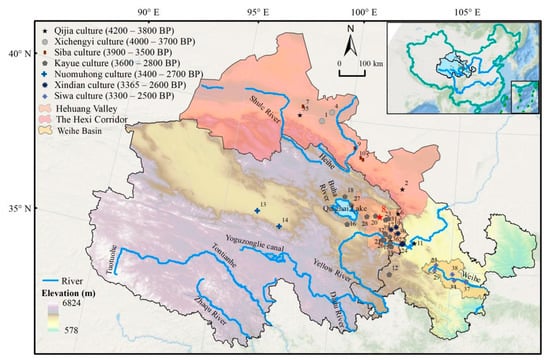
Figure 1.
Map of the study area showing the location of archaeological sites with barley and wheat in the Gansu–Qinghai region, northwest China. 1. Huoshiliang; 2. Huangniangniangtai; 3. Gongshijia; 4. Ganggangwa; 5. Donghuishan; 6. Jinchankou; 7. Shaguoliang; 8. Xiasunjiazhai; 9. Xichengyi; 10. Xihuishan; 11. Lijiaping; 12. Jiaoridang; 13. Talitalihasi; 14. Xiariyamakebu; 15. Luowalinchang; 16. Qiezha; 17. Huidui; 18. Lagalawaerma; 19. Shuangerdongping; 20. Lakashishuwan; 21. Tuanjie; 22. Erfang; 23. Weijiabao; 24. Wenjia; 25. Yaoshang; 26. Bayan; 27. Shangcaodalianhuxi; 28. Longshan; 29. Longxixihetan; 30. Yingpandi; 31. Xiawatai; 32. Lalongwa; 33. Lamuzui; 34. Qinjiaping; 35. Huoshaogou; 36. Yangou; 37. Ruji; 38. Laoyeshan; 39. Shawuang.
The Xiasunjiazhai site (36.74° N, 101.75° E; 2340 m; Figure 1) is located in Datong County, Xining City, Qinghai Province, in the eastern Gansu–Qinghai region. The site is located 11 km from the Huangshui River Valley, and the Beichuan River, which is a tributary of the Huangshui River, lies to the east of this site. According to survey reports from the National Cultural Heritage Administration, the total area of the Xiasunjiazhai site is approximately 60,000 m2, and the cultural layer is 0.5 to 1.2 m deep, which includes frog-pattern pottery shards and four-circle-pattern clay pottery fragments of the Machang-type Majiayao culture, as well as red pottery shards from the Qijia culture [30].
3. Materials and Methods
3.1. Samples
Flotation samples from the Xiasunjiazhai site: Ash pits in the Qijia cultural layer of the Xiasunjiazhai site were simply cleaned to a depth of 0.95–4.30 m, and flotation samples were collected systematically using the profile sampling method [31]. Based on the concentration of charcoal fragments visible to the naked eye, four soil samples with an average volume of 11 L (total volume of 44 L) were collected for flotation. Carbonized plant remains were collected using an 80-mesh sieve (aperture size 0.2 mm), then dried in the shade and sorted. Flotation was performed according to the bucket method [31] at the School of Geographical Sciences, Qinghai Normal University. Subsequently, the remains were sorted using mesh sieves with aperture sizes of 2, 1, 0.7, and 0.5 mm at the Laboratory of Plant Archaeology, School of Archaeology and Museology, Peking University. Remains with a particle size larger than 0.5 mm were selected, classified, and photographed under a stereo microscope; other remains were excluded from the analysis. Identification was based on modern plant specimens, ancient charred plant specimens, plant seed illustrations, and published documents [31,32,33,34]. Charred barley seeds from the Qijia cultural layer of the Xiasunjiazhai site were previously dated to 3340 ± 30 cal. a BP [21]. Therefore, in this study, only the charred wheat remains obtained by flotation were sent to Beta Analytic (United States) for AMS 14C dating.
Remains of Triticeae crops in the Gansu–Qinghai region: Previously published data on the locations, elevations, and AMS 14C dates of archaeological sites with barley or wheat from the Late Neolithic to Bronze Age in the Gansu–Qinghai region were also collected in this study. We selected the direct radiocarbon ages of individual barley and wheat grains themselves, rather than the ages of material from the associated archaeological contexts. These data were then unified according to the calendar year and corrected using the calibration curve for Northern Hemisphere atmospheric samples (IntCal20; https://c14.arch.ox.ac.uk, accessed on 25 July 2019; Supplementary Table S1).
3.2. Methods
3.2.1. Kernel Density Analysis
Kernel density analysis in ArcGIS is typically used to estimate spatial distribution and spatial aggregation areas [35]. The distance decay law in geography states that a larger weight assigned at a closer distance can be used to depict the spatial density features of a study area statistically and visually [36]. Therefore, the spatial distribution and aggregation areas of barley and wheat in the Gansu–Qinghai region were computed and graphically expressed using kernel density analysis and the distance decay law. The calculation formula is as follows.
where k is the kernel function, h is the bandwidth (km), n is the number of sites in the Gansu–Qinghai region, and di is the distance (km) between the valuation point and the observed location i. The value of h (search radius) directly affects the visualization results. After multiple attempts, a search radius of 10 km was chosen for a larger visual output grid to obtain kernel density distribution maps of barley and wheat in the Gansu–Qinghai region.
3.2.2. Interpolation Analysis
The spatial aggregation characteristics of Triticeae remains were obtained in the Gansu–Qinghai region by analyzing geographic location data via kernel density analysis. However, this analysis cannot reveal the distribution of Triticeae crops over time. Spatial interpolation in ArcGIS can simulate the predicted values of unknown regions based on the measured values of the sampled points, and has been widely used to analyze environments, soils, and digital surfaces [37,38,39]. In this study, seven interpolation methods (IDW, TSA, OK, EBK, DIB, LPI, and RBF) were used to investigate the characteristics of Triticeae crops in the Gansu–Qinghai region during the Late Neolithic to Bronze Age.
Specifically, to test the application of the above seven methods, we took barley remains from the Gansu–Qinghai region as an example. First, according to the AMS 14C dating results (Supplementary Table S1) of barley remains in the study area, the weight coefficient of the neighborhood cell increased as the age increased and decreased as the age decreased. Then, the distance between known and unknown points was processed with smoothing to assign values to unknown points and obtain the temporal change characteristics of barley remains. Second, we assessed the accuracy of different interpolation methods by calculating the error between the interpolation-predicted values and known values, and used the coefficient of determination (R2) and root mean square error (RMSE) as accuracy indicators. During the evaluation process, the R2 values were compared as a priority; the closer they were to 1, the better the interpolation result. For RMSE, the lower the value, the better the interpolation accuracy.
Here, n is the number of points, and T(xi) and P(xi) are the real and interpolated predicted ages of xi, respectively. Finally, we chose the most accurate of the seven methods to analyze barley and wheat remains and acquire their characteristics over time.
3.2.3. Surface and Hydrology Analysis
To determine the geographic characteristics of Triticeae crops in the Gansu–Qinghai region, buffer analysis in ArcGIS was used to process the landscape features based on the elevation of Triticeae remains. We also calculated the distance between Triticeae remains and the nearest river. Considering the low probability of diversion of the middle and upper reaches of the ancient Yellow River [40,41], we used the Euclidean distance from sites to present day rivers. DEM data with a resolution of 90 m, the 1:250,000 scale China river classification dataset, and the 1:100,000 scale China lake dataset were extracted from the mirror site conducted and published by the Computer Network Information Center, Chinese Academy of Science (http://www.gscloud.cn, accessed on 22 June 2020), and used for analysis in this study. The longitude and latitude of the archaeological sites were obtained from literature records, references, or replaced by those of the sampling points. The Euclidean distance method was used to calculate the distances between archaeological sites and rivers to determine the shortest distance from the sampling point of each site to the nearest water source. The principle was as follows: assuming that the coordinates of the archaeological site are (x1, y1), the coordinates of the nearest river are (x2, y2) and the shortest distance between the two is .
4. Results
4.1. The Morphology and Age of Triticeae Remains in the Gansu–Qinghai Region
Morphological observations were conducted on the charred remains of Triticeae crops obtained from the flotation of the Qijia cultural layer at the Xiasunjiazhai site. According to standard identification characteristics [34], the upper and lower ends of the charred barley grains were relatively symmetrical, the grains were spindle-shaped, and there was an oblong embryo at the bottom on the back of the grain and a relatively flat groin on the ventral surface (Figure 2a). The charred wheat grains were full, the upper end was relatively large and the lower end was small, the embryo on the back was round and located at the bottom of the grain, the side of the embryo was similar in shape to an irregular triangle with square bulges toward the back, and deep ventral grooves were observed on the ventral surface (Figure 2b). The upper and lower ends of the grains of naked barley were relatively symmetrical, the grains were fusiform but rounder than barley grains, and there were obvious dimples at the upper end, oblong embryos at the bottom of the back of the grain, and deep concave ventral cracks on the ventral surface (Figure 2c). The charred Triticeae remains comprised barley (18, 75%), wheat (7, 50%), and naked barley (5, 50%) (Table 1). Furthermore, the remains also included 29 carbonized foxtail millet seeds (Setaria italica, Figure 2d) and 12 carbonized broomcorn millet seeds (Panicum milliaceum, Figure 2e) with 100% ubiquity. There were also non–crop remains, including Panicoideae, Lamiaceae, and Polygonum (Table 1, Figure 2f–i).
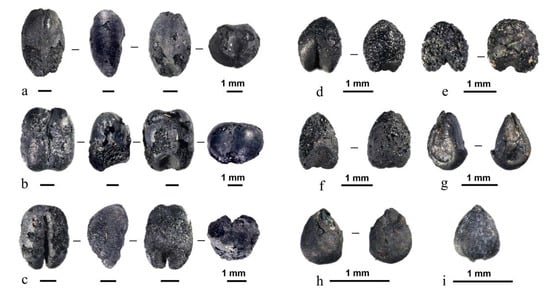
Figure 2.
Photographs of plant macro–remains from Xiasunjiazhai site. (a) Barley (Hordeum vulgare) (b) Wheat (Triticum aestivum) (c) Naked barley (Hordeum vulgare var. Nudum) (d) Foxtail millet (Setaria italica) (e) Broomcorn millet (Panicum miliaceum) (f) Panicoideae (g) Kochia (Kochia scoparia) (h) Lamiaceae (i) Polygonum. (a–c) the ventral side, lateral side, backside and apex of wheat, barley and naked barley from left to right. (d–h) the ventral side and backside of foxtail millet, broomcorn millet, Panicoideae, Kochia and Lamiaceae from left to right.

Table 1.
Identification results of plant macro-remains from Xiasunjiazhai site.
The radiocarbon dating results of charred wheat from the Xiasunjiazhai site was 3400 ± 30 cal. a BP (sample number: Beta-464983), and the calibrated age revised by OxCal IntCal20 was 3718–3564 cal. a BP. To ensure the accuracy of the age of Triticeae remains in the Gansu–Qinghai region, all ages were obtained by carbon-14 dating and all materials were either charred wheat or barley. According to the statistical results, 39 archaeological sites in the Gansu–Qinghai region contained barley remains from the Late Neolithic to Bronze Age (Supplementary Table S1), with a calibrated age range of 4086–2305 cal. a BP, whereas 26 contained wheat remains, with a calibrated age range of 3994–2355 cal. a BP (Supplementary Table S1).
4.2. The Spatiotemporal Distribution of Triticeae Remains in the Gansu–Qinghai Region
According to the kernel density analysis, the aggregation areas of barley and wheat in the exhibited substantial overlap, with three primary distribution areas. Hehuang Valley had the densest distribution of barley and wheat, followed by the Hexi Corridor and the Weihe River Basin (Figure 3). Wheat exhibited spatial aggregation greater than barley, with barley predominantly concentrated in the Hehuang Valley. We then analyzed and verified the temporal interpolation of barley remains using seven methods in ArcGIS, as shown in Figure 4. The analysis results indicated that the distribution of barley remains in the Gansu–Qinghai region shifted from northwest to southeast over the study period.
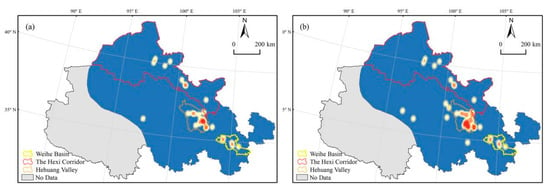
Figure 3.
Kernel density analysis of sites with (a) wheat and (b) barley in the Gansu–Qinghai region. The gray part of the map indicates there were no sites with wheat or barley in this region. The blue part of the map indicates sparse sites with wheat or barley were gathering in this region. The brown part of the map indicates plentiful sites with wheat or barley were gathering in this region.
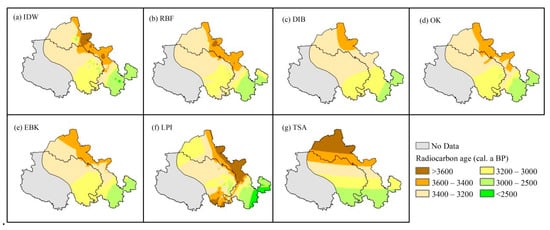
Figure 4.
Temporal interpolation results of sites with barley in the Gansu–Qinghai region based on seven interpolation methods.
To determine the accuracy of the visualization analysis results, we determined the R2 and RMSE values. Among the seven methods, IDW had the highest R2 (0.978) and smallest RMSE (68.65), followed by RBF (R2 = 0.909; RMSE = 111.24); the R2 values of the other five interpolation methods were all less than 0.4 (Figure 5). Thus, all methods exhibited less than ideal accuracy, with the R2 values decreasing in the following order: IDW > RBF > LPI > EBK > OK > TSA > DIB. In summary, IDW was the best method for visualizing the temporal distribution of barley in the Gansu–Qinghai region, so it was used for the spatial interpolation of radiocarbon dating of sites with barley and wheat. The study period was divided into three major stages and six minor stages according to the results (Figure 6a,b). Triticeae crops in the Gansu–Qinghai region exhibited a southward trajectory over time. At approximately 4000 BP, barley and wheat appeared almost simultaneously in the Hexi Corridor in the eastern Gansu–Qinghai region, which represented the main distribution area at this time. Over time, barley and wheat gradually expanded to the southern and eastern parts of the Gansu–Qinghai region. During 3600–3200 cal. a BP, barley and wheat remains were discovered in most areas of the Gansu–Qinghai region, primarily in the Hehuang Valley and Weihe River Basin. However, more archaeological sites with barley that were less than 3000 BP were observed in the eastern part of Qinghai Province.
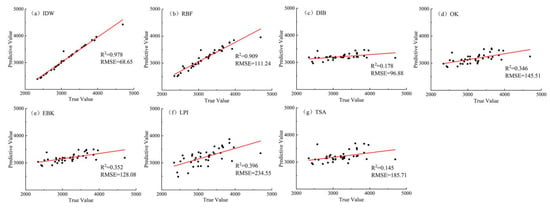
Figure 5.
Comparison of the temporal interpolation accuracy of seven interpolation methods for sites with barley in the Gansu–Qinghai region.
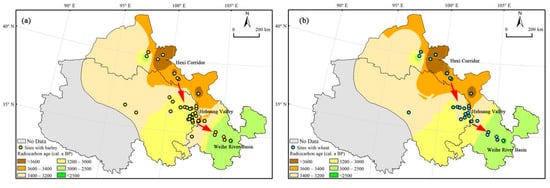
Figure 6.
Spatiotemporal distribution of sites with (a) barley and (b) wheat in the Gansu–Qinghai region.
4.3. Geographical Characteristics of Sites with Barley and Wheat
Euclidean distance analysis in ArcGIS was used to analyze the correlation between the spatial distribution of sites with barley and wheat in the Gansu–Qinghai region and the locations of the nearest rivers. As shown in Figure 7a, most sites were scattered along the course of rivers, in a linear or forked pattern, and near tributaries or lakes. Early Triticeae remains were primarily distributed around the inner waters of the Hexi Corridor, before spreading to the Yellow River and Huangshui River in eastern Qinghai Province. Late Triticeae were found further south, toward the Weihe River Basin. Sites that were located far from a river, such as the Huidui and Xihuishang sites, were predominantly located on the edge of oases of the seasonal pluvial fan, which were fed by melting ice in the summer and characterized by frequent precipitation. Most archaeological sites (46.2%) were within a 5-km radius of the nearest river (Table 2). The number of sites decreased steadily with distance from the nearest river, and only 5.1% of sites were located over 20 km from the nearest river. According to the spatial distribution of the study sites, most of sites were near the Hehuang Valley, which is the confluence between the Yellow River and the Huangshui River, followed by the Weihe River Basin, which is a tributary of the Yellow River. The average distance between sites with barley and the nearest river was 7.998 km, whereas that for wheat was 7.656 km, indicating a difference of approximately 300 m.
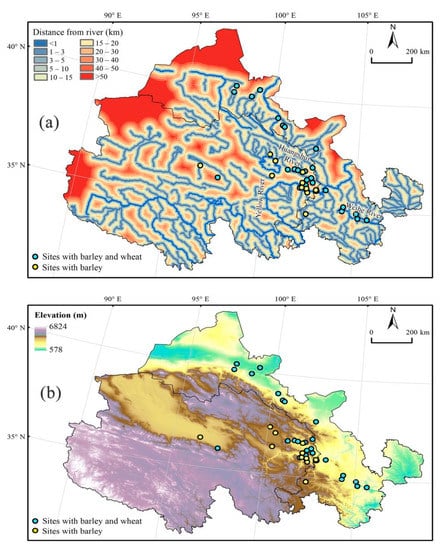
Figure 7.
(a) Distance from nearest river and (b) elevation of sites with barley and wheat in the Gansu–Qinghai region.

Table 2.
Distance from river for sites with barley and wheat in the Gansu–Qinghai region.
For every 100-m increase in elevation, the temperature decreases by 0.6 °C [42], which affects the accumulated temperature, as well as the growth cycle and distribution of Triticeae crops. As shown in Figure 7b, we extracted the elevation of each site using the latitude and longitude of sites in ArcGIS. Among the 39 sites with barley remains, the highest elevation was 3506 m (Jiaoridang site from the Kayue culture) and the lowest elevation was 1218 m (Ruiji site from the Siwa culture), with an average elevation of 2220.0 m. Most sites had elevations below 3000 m (87.2%) and below 2000 m (41.0%). Among the 26 sites with wheat remains, the highest elevation was 3064 m (Xiariyamakebu site from the Nuomuhong culture) and the lowest elevation was 1218 m (Ruiji site from the Siwa culture), with an average elevation of 2013.3 m. The proportion of sites with elevations below 3000 m and 2000 m was 96.2% and 57.7%, respectively. The average elevation of sites with barley was 2220.0 m, whereas that of sites with wheat was 2013.3 m, indicating a difference of approximately 200 m.
To comprehensively analyze the relationship between the sites with Triticeae remains, site elevation, and distance to the nearest river, we entered these data to the MATLAB software and used a normal fit distribution and p-value test to process the data (Figure 8). There was a non-normal distribution between sites with Triticeae remains and distance from the river (p < 0.05). The distance from the river was predominantly less than 5 km, which was likely related to the water requirements of farming or other daily activities. As shown in Figure 8b, there was a substantial normal distribution between Triticeae remains and elevation (p > 0.05). Triticeae remains were primarily distributed between 1500 m and 3000 m above sea level, and the number of sites decreasing with elevation. In other words, Triticeae remains were not randomly distributed in the study area but were concentrated in intermediate- and low-elevation areas. The main reason for this result may also be related to water resources and other human activities.
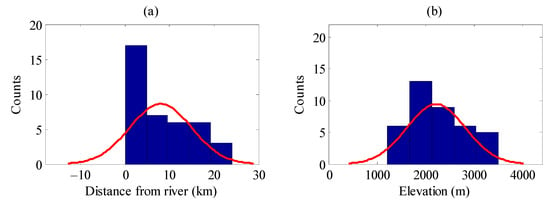
Figure 8.
The normal distribution fitted plot for the relationship between the sites with Triticeae remains in the Gansu–Qinghai region and (a) the distance from the nearest river (p = 0.003, <0.05); (b) the elevation (p = 0.429, >0.05).
5. Discussion
In recent years, abundant remains of Triticeae have been obtained from the Gansu–Qinghai region by flotation [16,20,21,22,23,25], which has greatly enhanced our knowledge of the distribution of Triticeae crops in this region from the Late Neolithic to the Bronze Age.
5.1. Spatial Distribution Characteristics
First, the spatial distribution of the Triticeae remains in the Gansu–Qinghai region revealed that the Hexi Corridor, the Hehuang Valley, and Weihe River Basin were the three main aggregation areas for Triticeae crops. According to the spatial interpolation results of 39 sites with barley and 26 sites with wheat, these crop sites exhibited a similar age and spatial distribution. However, barley remains showed a higher concentration, mainly in the Hehuang Valley. The number of archaeological sites with barley was 1.5 times than that of wheat, with the former exhibiting a wider distribution, even as far as the Tsaidam Basin, which result from the shorter growth cycle and greater environmental tolerance of barley [43].
Second, we compared seven interpolation methods to select the most appropriate method for reflecting the temporal change characteristics of Triticeae remains in the study area. Although our results showed that IDW was the most accurate method, it still exhibited some limitations. For example, the IDW results were overly sensitive to extreme value points, and the bullseye effect was evident in local areas. The other six interpolation methods showed higher smoothness but lower accuracy. In particular, the TSA interpolation results showed apparent striping and distortion. These findings are important for future research on the spatial distribution of Triticeae remains.
According to the age interpolation results of 65 archaeological sites with Triticeae remains in the Gansu–Qinghai region, Triticeae crops first appeared at the Huangniangniangtai site of Qijia culture and the Huoshiliang site of Xichengyi culture in the central Hexi Corridor during the Late Neolithic period, approximately 4000 BP. The subsequent spread of Triticeae crops in the Gansu–Qinghai region differed both temporally and spatially (Figure 6 and Supplementary Table S1). During 4000–3600 cal. a BP, nine archaeological sites contained Triticeae. Except for the Gongshijia and Xiasunjiazhai sites of Qijia culture, these sites were all distributed in the narrow strip of the Hexi Corridor. During 3600–3200 cal. a BP, of the 11 archaeological sites with Triticeae remains, eight sites were in the Hehuang Valley and three sites were in the Qinghai Lake or the Tsaidam Basin. During 3200–2300 cal. a BP, Triticeae remains were unearthed from 19 archaeological sites, including one site in the Hexi Corridor, 13 sites in Hehuang Valley, and 5 sites in the Weihe River Basin in the southernmost Gansu–Qinghai region. Furthermore, Triticeae remains dating back to 5200 and 4011 cal. a BP were discovered at the Tongtiandong site and the Xiaohe cemetery in Xinjiang Province, which lie to the north of the Gansu–Qinghai region [11,44], implying that the Hexi Corridor was likely the first area with Triticeae crops in the Gansu–Qinghai region, with Hehuang Valley and the Weihe River Basin also serving as major channels for their subsequent dispersal. In addition, during 4000–3600 cal. a BP, ancient settlers in the Hehuang Valley still predominantly consumed C4 crops including foxtail millet (Setaria italica) and broomcorn millet (Panicum milliaceum), with zero or rare consumption of C3 crops. After 3600 cal. a BP, the bone isotope in the Hehuang Valley showed a mixed signal of C3/C4, indicating that ancient people consumed Triticeae crops [45]. Notably, the Hexi Corridor, Hehuang Valley, and Weihe River Basin are still modern agricultural areas that supply essential food crops for human consumption in the Gansu–Qinghai region.
According to the spatial distribution characteristics of Triticeae crops and the development of local archaeological culture, the spatiotemporal evolution of Triticeae crops in the Gansu–Qinghai region was divided into three phases (4000–3600, 3600–3200, and 3200–2300 cal. a BP) and concentrated in the Hexi Corridor, Hehuang Valley, and Weihe River Basin, which are relatively suitable for agriculture. Moreover, wheat rachilla has been recovered from the Xichengyi, Shuangerdongping, and Lakashewan sites in the Gansu–Qinghai region [21,46], and its emergence was accompanied by a reduced proportion of weeds [5]. This evidence suggests that ancient humans in the Gansu–Qinghai region cultivated Triticeae crops and used field weed management practices, rather than simple commerce.
In summary, according to the spatial distribution characteristics of the barley and wheat remains, the earliest Triticeae crops recovered from the study area appeared as early as 4000 cal. a BP. The geographical expansion of these crops varied both spatially and temporally and was strongly related to the Hexi Corridor, Hehuang Valley, and Weihe River Basin. However, the results of this part only show the spatiotemporal distribution of barley and wheat in the Gansu-Qinghai region, but the geographical reasons for this phenomenon are unclear.
5.2. Influence of Geographical Factors
Regarding the geographical factors affecting Triticeae crop distribution, barley and wheat remains were found near rivers, with an average distance of approximately 8.0 km from the nearest river, which could be related to the large water requirements during the growth cycle of Triticeae crops. The growth cycle of barley and wheat can be divided into tillering, elongation, heading, and maturation stages [47,48,49], with the elongation and heading stages representing growth peaks with the highest water consumption [50]. Modern agricultural research shows that irrigation is a key requirement for the cultivation of Triticeae crops in the arid climate of the Gansu–Qinghai region [51,52]. Similarly, our previous research [53] showed that normal cultivation required artificial irrigation of prehistoric sites at around 4000 cal. a BP in the Gansu–Qinghai region, when the annual precipitation was less than 400 mm. Because the average annual precipitation in most areas of the study area is less than 400 mm, the need for frequent irrigation during Triticeae crop cultivation was likely the primary reason for the distribution of Triticeae sites along rivers. Moreover, wheat has an environmental tolerance lower than barley [43], which could explain why wheat was typically found closer to rivers.
The elevation of the sites affects the temperature, which influences the suitability of Triticeae crops. According to our statistical analysis, Triticeae remains in the Gansu–Qinghai region were mostly distributed below 3000 m above sea level, where the terrain slopes gently and is ideal for living and farming. As the elevation increased, the number of sites decreased. Figure 9 shows the elevation of the sites according to their radiocarbon age. The elevation of sites with Triticeae gradually decreased over time, indicating that Triticeae crops expanded into warmer, lower elevation areas over time.
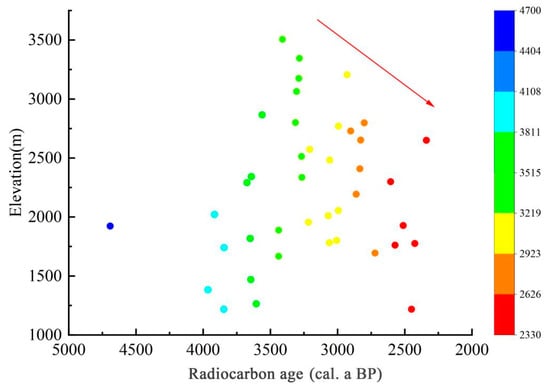
Figure 9.
Scatter plot of the elevation and radiocarbon age of Triticeae remains in the Gansu–Qinghai region. The red arrow indicates the elevation of the sites with wheat or barley decreased gradually as time goes on in this region.
In addition, accumulated temperature is an important factor that affects the growth cycle and the distribution range of crops. Because the accumulated temperature decreases with increasing elevation, the distribution of Triticeae crops was limited at various elevations. The Triticeae remains in this study date from 4000 to 2300 cal. a BP; however, it is difficult to determine the temperature fluctuations in different parts of the study area over the last 4000 years. According to climate reconstruction data for the Delingha area of the eastern Qinghai–Tibet Plateau [54], the temperature was similar between 3700–2300 cal. a BP and 1900–2000 AD. According to Climate Research Unit time-series (CRU TS) data (Version 4.05) from the School of Environmental Sciences, University of East Anglia, United Kingdom (https://catalogue.ceda.ac.uk/uuid/c26a65020a5e4b80b20018f148556681, accessed on 2 July 2021), we calculated the mean temperature for 1900–2000 AD in the Gansu–Qinghai region. Subsequently, the mean temperature was used to assess the interpolation values between the ancient accumulated temperature and Triticeae remains. Because of the difficulty in analyzing the entire raster layer, a random scatter function in ArcGIS was used to investigate the relationship between elevation, temperature, and AMS 14C ages of sites with Triticeae remains. In total, 64 points were selected throughout the Gansu–Qinghai region (Figure 10), and their temperatures and elevations were extracted from CRU TS data and mirror sites published by the Computer Network Information Center, Chinese Academy of Science, respectively. These data were then analyzed by MATLAB with chronological interpolation of the sites with barley and wheat (Figure 6).
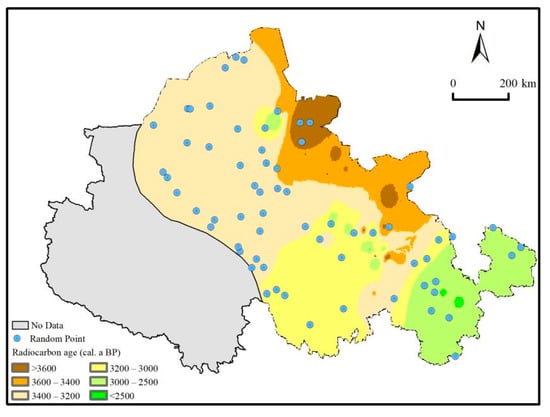
Figure 10.
Random points (n = 64) in the Gansu–Qinghai region.
The results in Figure 11a,b indicate that there was a general negative correlation between temperature and elevation, with the temperature decreasing as elevation increases, which would have affected the suitability of Triticeae crops. The higher the elevation, the later Triticeae remained (Figure 11c), indicating that Triticeae crops spread along areas of lower elevations and higher temperature over time. The regression analysis between the temperature and the radiocarbon age of Triticeae remains revealed a negative correlation (Figure 11d), indicating that Triticeae appeared later as the temperature increased. Although only 64 random points were chosen for this study, the results of the analysis also demonstrated that elevation and temperature both affect the temporal distribution of Triticeae crops in this region. However, barley and wheat have different response mechanisms to accumulated temperature. Agronomic studies have shown that barley has a shorter growth cycle and stronger environmental tolerance than wheat [55]. The Photoperiod-H1 (Ppd-H1) gene involved in flowering time was identified for the first time by Turner et al. [56]. Mutations in the Ppd-H1 gene lead to the closure of the photoperiodic response of barley, so that barley can grow in various seasonal patterns and adapt to the cold climate at extreme latitudes and high elevations [56,57,58]. Tolerance and gene mutation during barley domestication may be the major reasons why barley remains had a higher and wider distribution than wheat remains in the Gansu–Qinghai region from the Late Neolithic to the Bronze Age.
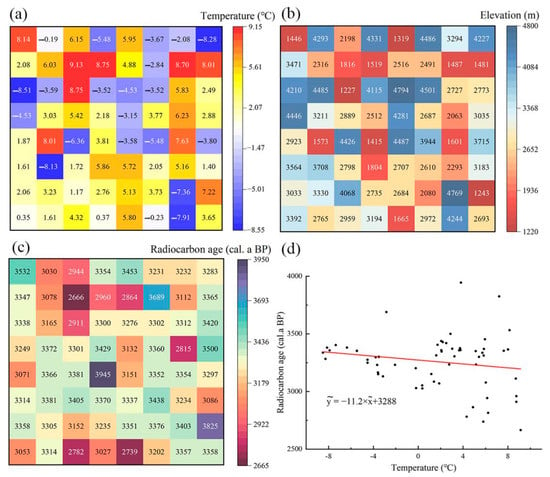
Figure 11.
(a) Regional temperature, (b) regional elevation, and (c) radiocarbon age of sites with barley and wheat recovered from chronological interpolation in this study, (d) regression analysis of radiocarbon age and temperature.
In summary, according to the geographical factors of the barley and wheat remains, the distribution and spread of the Triticeae remains in the Gansu–Qinghai region was probably influenced by the location of the nearest river, the accumulated temperature, and regional climatic change. Furthermore, compared to wheat, barley had a wider distribution area due to the better environmental tolerance.
6. Conclusions
From the Late Neolithic to the Bronze Age, cultural interactions were frequent in the Gansu–Qinghai region. Because of cultural collision, exchange, and integration, barley and wheat originating from western Asia entered and spread gradually throughout this region. In this study, 65 sites with charred barley and wheat remains were studied to explore the spatiotemporal distribution of Triticeae crops and the geographic factors controlling their distribution in the Gansu–Qinghai region. According to our results and previous archaeological data, we demonstrate that: (1) from the Late Neolithic Age to the Bronze Age, Triticeae remains unearthed in the Gansu–Qinghai region showed temporal and spatial variations. The spatiotemporal evolution of Triticeae crops can be divided into three phases: primarily in the Hexi Corridor from 4000 to 3600 cal. a BP, primarily in Hehuang Valley and Qinghai Lake from 3600 to 3200 cal. a BP, and primarily in the Hehuang Valley and the Weihe River Basin from 3200 to 2300 cal. a BP. (2) The distribution and spread of Triticeae remains in the Gansu–Qinghai region was likely influenced by the location of the nearest river, the accumulated temperature, and regional climatic change. This study provides insights into the agricultural activities, social structure, cultural communication, and socioeconomic factors related to prehistoric Triticeae crops in the Gansu–Qinghai region of northwest China.
Supplementary Materials
The following supporting information can be downloaded at: https://www.mdpi.com/article/10.3390/su14095417/s1, Table S1: Location, elevation, radiocarbon age, and nearest river data from river for sites with barley and wheat in the Gansu–Qinghai region. References [59,60,61,62] are cited inSupplementary Materials.
Author Contributions
Conceptualization, Z.M., X.W. and J.S.; Data curation, Z.M. and X.W.; Methodology, Z.M.; Project administration, Z.M., G.H. and X.H.; Writing—review & editing, Z.M., J.S., X.W., G.H. and X.H. All authors have read and agreed to the published version of the manuscript.
Funding
This research was funded by the National Natural Science Foundation of China (Grant Nos. 41807436, 42171165 and 41907372).
Institutional Review Board Statement
Not applicable.
Informed Consent Statement
Not applicable.
Data Availability Statement
The data used in the current study are available from the corresponding authors.
Acknowledgments
The authors acknowledge the editor and reviewers of this paper, for their constructive comments and suggestions; The authors thank Zhenghua Deng from Peking University, Ruina Bai and Xuan Yi from Northwest University, and Lei Hua from China University of Geosciences (Wuhan) for their help with word processing, graphics, and data interpretation.
Conflicts of Interest
The authors declare no conflict of interest.
References
- Flad, R.; Li, S.C.; Wu, X.H.; Zhao, Z.J. Early wheat in China: Results from new studies at Donghuishan in the Hexi Corridor. Holocene 2010, 20, 955–965. [Google Scholar] [CrossRef]
- Dodson, J.R.; Li, X.Q.; Zhou, X.Y.; Zhao, K.L.; Sun, N.; Atahan, P. Origin and spread of wheat in China. Quat. Sci. Rev. 2013, 72, 108–111. [Google Scholar] [CrossRef]
- Liu, X.Y.; Lister, D.L.; Zhao, Z.J.; Staff, R.A.; Jones, P.J.; Zhou, L.P.; Pokharia, A.K.; Petrie, C.A.; Pathak, A.; Lu, H.L.; et al. The virtues of small grain size: Potential pathways to a distinguishing feature of Asian wheats. Quat. Int. 2016, 426, 107–119. [Google Scholar] [CrossRef] [Green Version]
- Stevens, C.J.; Murphy, C.; Roberts, R.; Lucas, L.; Silva, F.; Fuller, D.Q. Between China and South Asia: A middle Asian corridor of crop dispersal and agricultural innovation in the Bronze Age. Holocene 2016, 26, 1541–1555. [Google Scholar] [CrossRef]
- Ren, L.L.; Dong, G.H.; Liu, F.W.; D’Alpoim-Guedes, J.; Flad, R.K.; Ma, M.M.; Li, H.M.; Yang, Y.S.; Liu, Y.J.; Zhang, D.J.; et al. Foraging and farming: Archaeobotanical and zooarchaeological evidence for Neolithic exchange on the Tibetan Plateau. Antiquity 2020, 94, 637–652. [Google Scholar] [CrossRef] [Green Version]
- Chen, X.C. Wheat as food—Archaeological discoveries of early wheat in China in recent years and its significance. J. Chin. Culin. Cult. 2008, 4, 1–17. (In Chinese) [Google Scholar]
- Zhao, Z.J. Wheat spreads eastward and Eurasian steppe route. J. Three. Gener. Archaeol. 2009, 1, 456–459. (In Chinese) [Google Scholar]
- Zhao, Z.J. Study on the introduction of wheat into China-The date of Archaeobotany. Cult. Relics. S. Chin. 2015, 3, 44–52. (In Chinese) [Google Scholar]
- Zeder, M.A. Domestication and early agriculture in the Mediterranean Basin: Origins, diffusion, and impact. Proc. Natl. Acad. Sci. USA 2008, 105, 11597–11604. [Google Scholar] [CrossRef] [Green Version]
- Riehl, S.; Zeidi, M.; Conard, N.J. Emergence of agriculture in the foothills of the Zagros Mountains of Iran. Science 2013, 341, 65–67. [Google Scholar] [CrossRef]
- Zhou, X.Y.; Yu, J.J.; Spengler, R.N.; Shen, H.; Zhao, K.L.; Ge, J.Y.; Bao, Y.G.; Liu, J.C.; Yang, Q.J.; Chen, G.H.; et al. 5200-year-old cereal grains from the eastern Altai Mountains redate the Trans-Eurasian crop exchange. Nat. Plants 2020, 6, 78–87. [Google Scholar] [CrossRef] [PubMed]
- Li, F.; Li, J.Y.; Lu, Y.; Bai, P.; Cheng, H.F. Neodiscovery of the ancient remains of agriculture in the Neolithic site of Dong-hui Hill at Min-luo County in Gansu. Agric. Archaeol. 1989, 1, 56–69. (In Chinese) [Google Scholar]
- Jin, G.Y. Archaeological discovery and research of early wheat in China. Agric. Archaeol. 2007, 4, 11–20. (In Chinese) [Google Scholar]
- Chen, X.X.; Wang, L.Z.; Wang, Q. Flotation results from the 2006–2007 excavation of Xijincheng site in Boai, Henan Province. J. Huaxia. Archaeol. 2010, 3, 67–76. (In Chinese) [Google Scholar]
- Spengler, R.N. Agriculture in the central Asian Bronze Age. J. World Prehistory 2015, 28, 215–253. [Google Scholar] [CrossRef]
- Chen, F.H.; Dong, G.H.; Zhang, D.J.; Liu, X.Y.; An, C.B. Agriculture facilitated permanent human occupation of the Tibetan Plateau after 3600 BP. Science 2015, 347, 248–250. [Google Scholar] [CrossRef]
- Dong, G.H.; Yang, Y.S.; Han, J.Y.; Wang, H.; Chen, F.H. Prehistoric cultural exchange between east and west in Eurasia from the perspective of crop communication. Sci. Sin. Terr. 2017, 47, 530–543. (In Chinese) [Google Scholar]
- Kuzmina, E.E. The Prehistory of the Silk Road; University of Pennsylvania Press: Philadelphia, PA, USA, 2008; pp. 39–108. [Google Scholar]
- Anthony, D.W. The Horse, the Wheel, and Language: How Bronze Age Riders from the Eurasian Steppes Shaped the Modern World; Princeton University Press: Princeton, NJ, USA, 2010; pp. 121–456. [Google Scholar]
- Zhao, Z.J.; Wang, W.; Xu, X.G.; Niu, S.S.; Cai, L.H.; Song, J.N.; Xiao, Y.M.; Zhang, C.S.; Yang, J.G. Analysis report on flotation results of Kayue Cultural site in Fengtai, Huzhu, Qinghai Province. Archaeol. Cult. Relics. 2004, 2, 85–91. (In Chinese) [Google Scholar]
- Jia, X. Cultural Evolution Process and Plant Remains during Neolithic-Bronze Age in Northeast Qinghai Province; Lanzhou University: Lanzhou, China, 2012; pp. 1–180. (In Chinese) [Google Scholar]
- Dong, G.H.; Yang, Y.; Ren, X.X.; Wang, Z.X. Early barley and wheat remains found at Jinchankou Qijia cultural site in Qinghai Province. Chin. Cult. Relic. News. 4 July 2014. (In Chinese) [Google Scholar]
- Yang, Y. The Analysis of Charred Plant Seeds at Jinchankou Site and Lijiaping Site During Qijia Culture Period in the Hehuang Region China; Lanzhou University: Lanzhou, China, 2014; pp. 1–72. (In Chinese) [Google Scholar]
- Yang, Y.S. The Transition of Human Subsistence Strategy and Its Influencing Factors during Prehistoric Times in the Hexi Corridor, Northwest China; Lanzhou University: Lanzhou, China, 2017; pp. 1–196. (In Chinese) [Google Scholar]
- Chen, T.T. Analysis on Agricultural Development History and Influential Factors in the Upper Reaches of Wei River Region during the 5500-2000 BP; Lanzhou University: Lanzhou, China, 2020; pp. 1–72. (In Chinese) [Google Scholar]
- Wu, J.H.; Li, Z.B.; Shen, Z.Y. Variation trend of precipitation and climate factors in Gansu Province for the Last 50 Years. J. Arid. Land. Res. Environ. 2008, 22, 24–29. (In Chinese) [Google Scholar]
- Bai, S.Y.; Shi, J.Q.; Xiang, D.; Wang, G.E. Spatiotemporal pattern change of precipitation in Qinghai in the Last 50 Years. J. Arid. Land. Res. Environ. 2013, 27, 148–153. (In Chinese) [Google Scholar]
- An, C.B.; Wang, L.; Ji, D.X.; Chen, F.H.; Wang, P. The temporal and spatial changes of Neolithic Cultures in Gansu-Qinghai Region and possible environmental forcing. Quat. Sci. 2006, 6, 923–927. (In Chinese) [Google Scholar]
- Yao, J.Q.; Yang, Q.; Liu, Z.H.; Li, C.Z. Spatio-temporal change of precipitation in arid region of the northwest China. Acta. Ecol. Sin. 2015, 35, 5846–5855. (In Chinese) [Google Scholar]
- National Cultural Heritage Administration. Atlas of Chinese Cultural Relics. Qinghai Volume; China Cartographic Publishing House: Beijing, China, 1996; pp. 1–343. (In Chinese) [Google Scholar]
- Zhao, Z.J. Paleoethnobotany: Theories, Methods and Practice; Science Press: Beijing, China, 2010; p. 38. (In Chinese) [Google Scholar]
- Guan, G.Q.; Zhang, Y.R.; Sun, G.Y.; Ding, S.X.; Wang, Y.B. Illustrated Handbook of Weed Seed; Science Press: Beijing, China, 2000; pp. 1–364. (In Chinese) [Google Scholar]
- Liu, C.J.; Jin, G.Y.; Kong, Z.C. Archaeobotany—Research on Seeds and Fruits; Science Press: Beijing, China, 2008; pp. 1–273. (In Chinese) [Google Scholar]
- Jiang, Y.C.; Wang, H.; Li, S.C. Flotation results of Donghuishan site in Minle, Gansu, Province. Archaeol. Cult. Relics. 2017, 1, 119–128. (In Chinese) [Google Scholar]
- Davis, R.A.; Lii, K.S.; Politis, D.N. Remarks on Some Nonparametric Estimates of a Density Function. In Selected Works of Murray Rosenblatt; Springer: New York, NY, USA, 2011; pp. 95–100. [Google Scholar]
- Tu, T.Q.; Chen, J.G.; Wei, Y.H.; Liang, Q.C.; Zhang, Y.H. Spatial structure and evolution of basic education facilities in Nanjing in China. J. Univ. Chin. Acad. Sci. 2018, 35, 66–74. (In Chinese) [Google Scholar]
- Wang, Y.Q.; Bai, Y.R.; Wang, J.Y. Distribution of Urban Soil Heavy Metal and Pollution Evaluation in Different Functional Zones of Yinchuan City. Environ. Sci. 2016, 37, 710–716. (In Chinese) [Google Scholar]
- Wang, S.B.; Wang, Y. Comparative research on typical spatial interpolation methods for cancer data in small regions. Geogr. Res. 2021, 40, 2102–2118. (In Chinese) [Google Scholar]
- Ren, Y.M.; Gao, Y.B.; Liu, Y. Research Progress and Prospect of Spatial Interpolation Method for Cultivated Land Quality. Chin. Agric. Sci. Bull. 2021, 37, 45–50. (In Chinese) [Google Scholar]
- Liu, W.; Shi, C.X.; Zhou, Y.Y. Trends and attribution of runoff changes in the upper and middle reaches of the Yellow River in China. J. Hydro-Environ. Res. 2021, 37, 57–66. [Google Scholar] [CrossRef]
- Yuan, G.K. Alterations in The Yellow River’s Course and Changes in Civilization Seen in Terms of Archaeology. Social Sci. Chin. 2021, 2, 123–143. (In Chinese) [Google Scholar]
- Zong, Z.K.; Shi, H.N. Study on the influence of high altitude environment on temperature rise of ACB. Elec. Ener. Manag. Technol. 2017, 11, 19–22. [Google Scholar]
- Jalalian, A.; Givi, J.; Bazgir, M.; Ayoubi, S. Qualitative, Quantitative and Economic Evaluation of land suitability for barley, wheat and chickpea in rainfed area of Talandasht District (Kermanshah Province). J. Sci. Technol. Agric. Natl. Res. 2007, 10, 91–106. [Google Scholar]
- Jiang, H.E.; Zhang, Y.B.; Li, X.; Yao, Y.F.; Ferguson, D.K.; Lü, E.G.; Li, C.S. Evidence for early viticulture in China: Proof of a grapevine (Vitis vinifera L., Vitaceae) in the Yanghai Tombs, Xinjiang. J. Archaeol. Sci. 2009, 36, 1458–1465. [Google Scholar] [CrossRef]
- Ma, M.M. Human Dietary Changes and Agriculture Developments in the Hehuang and Contiguous Regions in the Second Millennium BC-Stable Isotopic Evidence; Lanzhou University: Lanzhou, China, 2012; pp. 1–128. (In Chinese) [Google Scholar]
- Fan, X.J. Analysis of Carbonized Botanic Remains in XiChengyi Site; Shandong University: Jinan, China, 2016; pp. 1–104. (In Chinese) [Google Scholar]
- Xu, S.J.; Gu, X.L.; Zhuang, H.Y.; Xu, R.G.; Yuan, J.; Wu, T.X. Modeling apical and phenological development stages in barley. J. Tritic. Crops 2006, 26, 123–127. (In Chinese) [Google Scholar]
- Xu, S.J.; Gu, X.L.; Xu, R.G.; Yang, J.X.; Xi, W.J.; Zhuang, H.Y. Modeling the dynamics of spike and internode growth in barley. J. Tritic. Crops 2007, 27, 282–287. (In Chinese) [Google Scholar]
- Fu, Q.S. Wheat growth and development and its requirements for external environmental conditions. Sci. Technol. Innov. 2010, 14, 117. (In Chinese) [Google Scholar]
- Huang, M.J.; Jin, F.S.; Chi, B.L.; Chen, Q.E. A study on characteristics of water consumption in winter wheat under plastic covering. Agric. Res. Arid. Areas. 1999, 17, 20–23. (In Chinese) [Google Scholar]
- Li, C.X.; Jiang, J.Q.; Yang, X.Y.; Wang, Y. Effects of wheat field irrigation on soil temperature and wheat. Sci. Technol. Qinghai. Agric. For. 1996, 1, 4–8. (In Chinese) [Google Scholar]
- Zhang, T.; Li, W.R.; Mao, Z.X.; Zhang, M. Water demand rule of beer barley and soil moisture variation characteristics in Hexi Region. Chin. Agric. Sci. Bull. 2019, 35, 89–93. (In Chinese) [Google Scholar]
- Hou, G.L.; Xu, C.J.; Xiao, J.Y. Comparative analysis of prehistoric sites distribution around 4 ka B.P. in Gansu-Qinghai Region based on GIS. Sci. Geogr. Sin. 2012, 32, 116–120. (In Chinese) [Google Scholar]
- Yang, B.; Qin, C.; Bräuning, A.; Osborn, T.J.; Trouet, V.; Ljungqvist, F.C.; Esper, J.; Schneide, L.; Grießinge, J.; Büntgen, U.; et al. Long-term decrease in Asian Monsoon Rainfall and abrupt climate change events over the past 6700 years. Proc. Natl. Acad. Sci. USA 2021, 118, e2102007118. [Google Scholar] [CrossRef]
- Guo, S.X. Comparative study on drought resistance adaptability of barley and wheat. Gansu. Agric. Sci. Technol. 1998, 3, 23–25. (In Chinese) [Google Scholar]
- Turner, A.; Beales, J.; Faure, S.; Dunford, R.P.; Laurie, D.A. The Pseudo-response regulator Ppd-H1 provides adaptation to photoperiod in barley. Science 2005, 310, 1031–1034. [Google Scholar] [CrossRef] [PubMed]
- Jones, H.; Leigh, F.J.; Mackay, I.; Bower, M.A.; Smith, L.M.J.; Charles, M.P.; Jones, G.; Jones, M.K.; Brown, T.A.; Powell, W. Population-based resequencing reveals that the flowering time adaptation of cultivated barley originated east of the fertile crescent. Mol. Biol. Evol. 2008, 25, 2211–2219. [Google Scholar] [CrossRef] [PubMed] [Green Version]
- Liu, X.Y.; Lister, D.L.; Zhao, Z.J.; Petrie, C.A.; Zeng, X.S.; Jones, P.J.; Staff, R.A.; Pokharia, A.K.; Bates, J.; Singh, R.N.; et al. Journey to the East: Diverse routes and variable flowering times for wheat and barley en route to prehistoric China. PLoS ONE 2017, 12, e0187405. [Google Scholar] [CrossRef] [PubMed] [Green Version]
- Dodson, J.R.; Li, X.; Ming, J. Early bronze in two Holocene archaeological sites in Gansu, NW China. Quaternary Res. 2009, 72, 309–314. [Google Scholar] [CrossRef]
- Atahan, P.; Dodson, J.; Li, X. Subsistence and the isotopic signature of herding in the Bronze Age Hexi Corridor, NW Gansu, China. Quaternary Int. 2011, 27, 279–280. [Google Scholar] [CrossRef]
- Li, X.Q.; Sun, N.; Dodson, J. The impact of early smelting on the environment of Huoshiliang in Hexi Corridor, NW China, as recorded by fossil charcoal and chemical elements. Palaeogeogr. Palaeoclimatol. Palaeoecol. 2011, 305, 329–336. [Google Scholar] [CrossRef]
- 14C Laboratory of the Center for Scientific Archaeology, Institute of Archaeology; CASS. Report of 14C Dates (41). Archaeology 2015, 7, 107–109. (In Chinese) [Google Scholar]
Publisher’s Note: MDPI stays neutral with regard to jurisdictional claims in published maps and institutional affiliations. |
© 2022 by the authors. Licensee MDPI, Basel, Switzerland. This article is an open access article distributed under the terms and conditions of the Creative Commons Attribution (CC BY) license (https://creativecommons.org/licenses/by/4.0/).